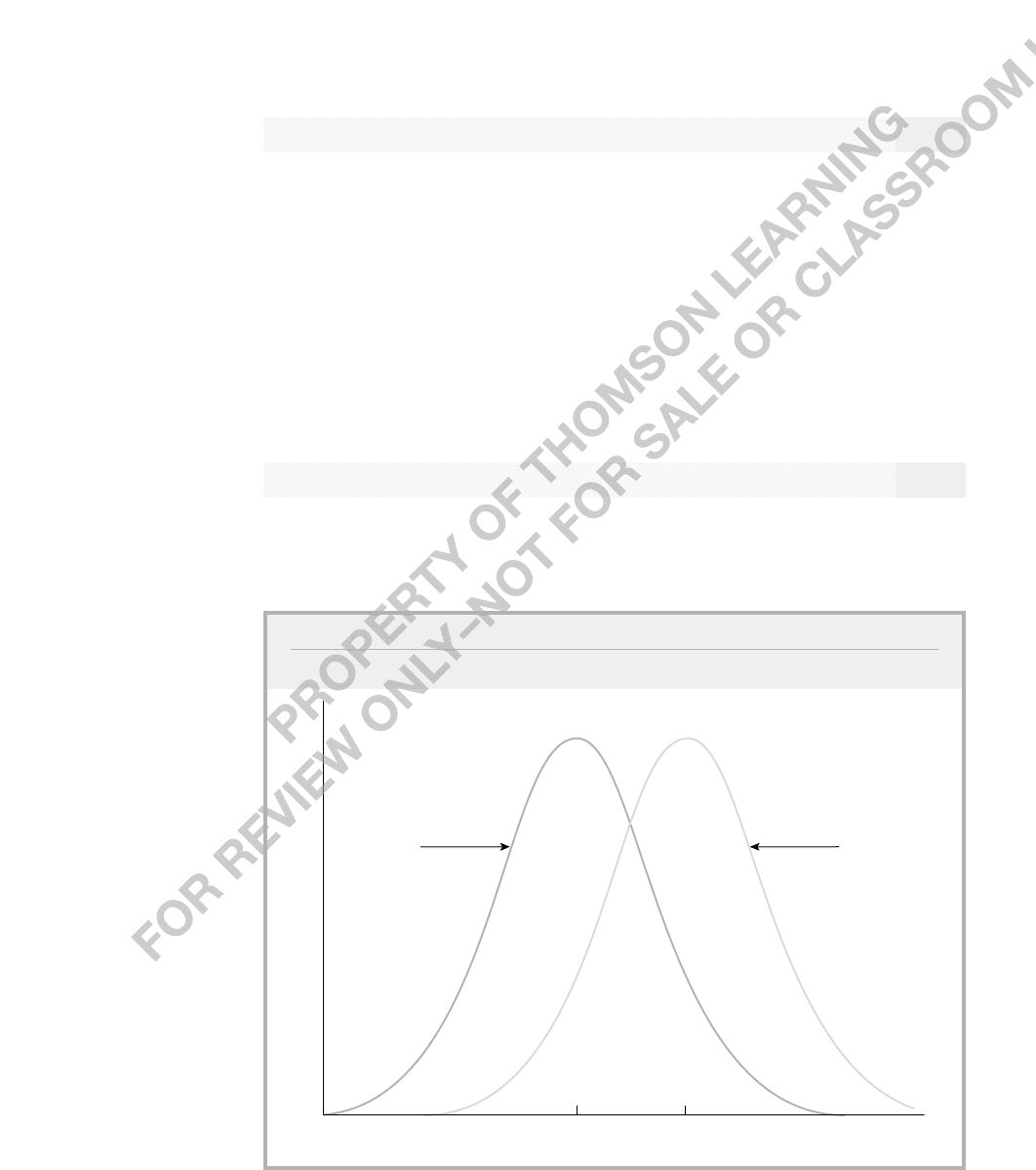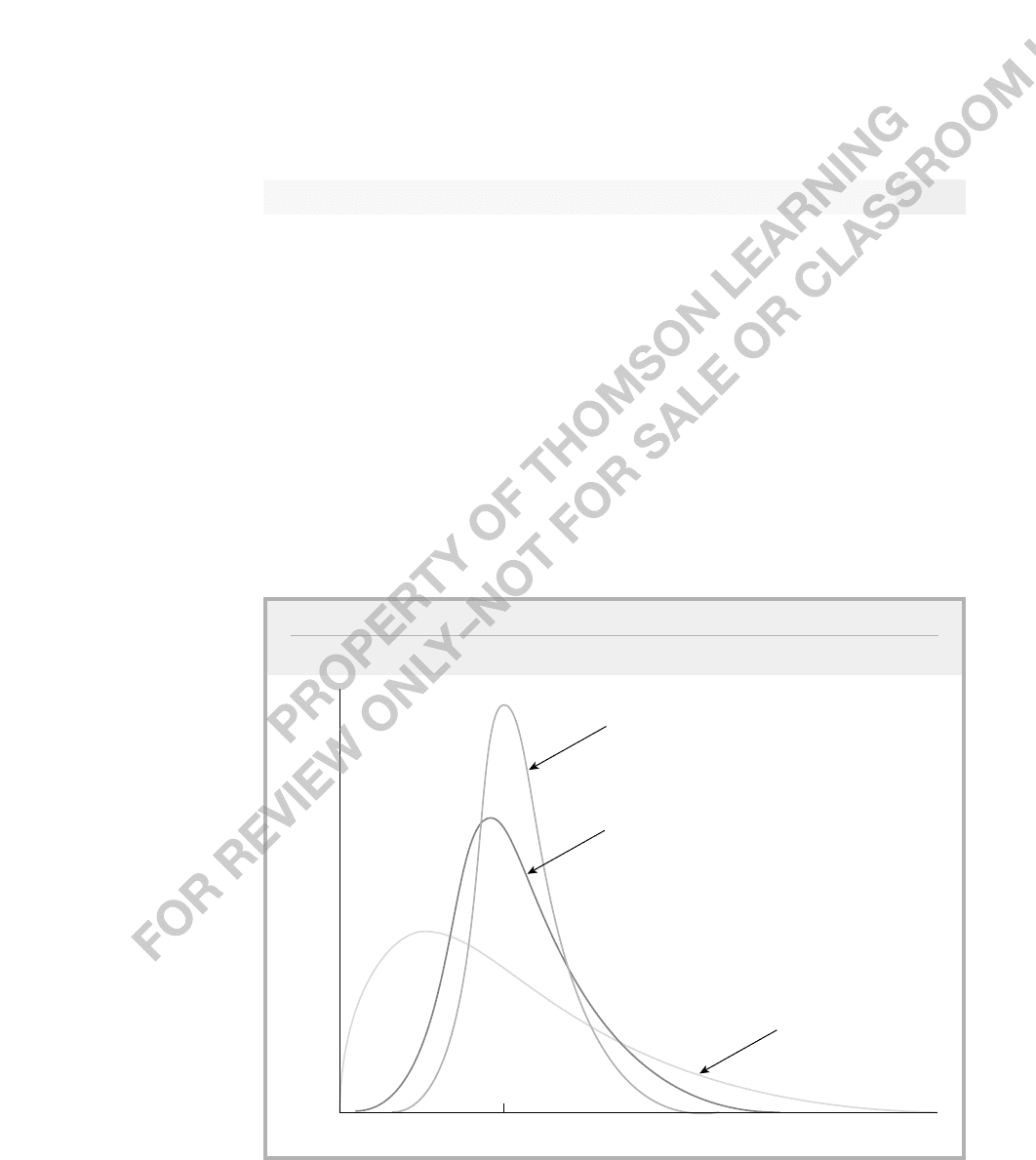Wooldridge J. Introductory Econometrics: A Modern Approach (Basic Text - 3d ed.)
Подождите немного. Документ загружается.


Section C.3, we cover “asymptotic properties,” which have to do with the behavior of
estimators as the sample size grows without bound.
Estimators and Estimates
To study properties of estimators, we must define what we mean by an estimator. Given
a random sample {Y
1
,Y
2
,…,Y
n
} drawn from a population distribution that depends on an
unknown parameter u, an estimator of u is a rule that assigns each possible outcome of
the sample a value of u. The rule is specified before any sampling is carried out; in par-
ticular, the rule is the same regardless of the data actually obtained.
As an example of an estimator, let {Y
1
,…,Y
n
} be a random sample from a population
with mean m. A natural estimator of m is the average of the random sample:
Y
¯
n
1
n
i1
Y
i
. (C.1)
Y
¯
is called the sample average but, unlike in Appendix A where we defined the sample
average of a set of numbers as a descriptive statistic, Y
¯
is now viewed as an estimator.
Given any outcome of the random variables Y
1
,…,Y
n
, we use the same rule to estimate
m: we simply average them. For actual data outcomes {y
1
,…,y
n
}, the estimate is just the
average in the sample: y¯ (y
1
y
2
… y
n
)/n.
EXAMPLE C.1
(City Unemployment Rates)
Suppose we obtain the following sample of unemployment rates for 10 cities in the United
States:
City Unemployment Rate
1 5.1
2 6.4
3 9.2
4 4.1
5 7.5
6 8.3
7 2.6
Appendix C Fundamentals of Mathematical Statistics 765
(continued)

City Unemployment Rate
8 3.5
9 5.8
10 7.5
Our estimate of the average city unemployment rate in the United States is y¯ 6.0. Each
sample generally results in a different estimate. But the rule for obtaining the estimate is the
same, regardless of which cities appear in the sample, or how many.
More generally, an estimator W of a parameter u can be expressed as an abstract math-
ematical formula:
W h(Y
1
,Y
2
,…,Y
n
),
(C.2)
for some known function h of the random variables Y
1
,Y
2
,…,Y
n
. As with the special case
of the sample average, W is a random variable because it depends on the random sample:
as we obtain different random samples from the population, the value of W can change.
When a particular set of numbers, say, {y
1
,y
2
,…,y
n
}, is plugged into the function h,we
obtain an estimate of u, denoted w h(y
1
,…,y
n
). Sometimes, W is called a point esti-
mator and w a point estimate to distinguish these from interval estimators and estimates,
which we will come to in Section C.5.
For evaluating estimation procedures, we study various properties of the probability
distribution of the random variable W. The distribution of an estimator is often called its
sampling distribution, because this distribution describes the likelihood of various out-
comes of W across different random samples. Because there are unlimited rules for com-
bining data to estimate parameters, we need some sensible criteria for choosing among
estimators, or at least for eliminating some estimators from consideration. Therefore, we
must leave the realm of descriptive statistics, where we compute things such as sample
average to simply summarize a body of data. In mathematical statistics, we study the sam-
pling distributions of estimators.
Unbiasedness
In principle, the entire sampling distribution of W can be obtained given the probability
distribution of Y
i
and the function h. It is usually easier to focus on a few features of the
distribution of W in evaluating it as an estimator of u. The first important property of an
estimator involves its expected value.
UNBIASED ESTIMATOR. An estimator, W of u, is an unbiased estimator if
766 Appendix C Fundamentals of Mathematical Statistics

E(W) u, (C.3)
for all possible values of u.
If an estimator is unbiased, then its probability distribution has an expected value equal to
the parameter it is supposed to be estimating. Unbiasedness does not mean that the esti-
mate we get with any particular sample is equal to u, or even very close to u. Rather, if
we could indefinitely draw random samples on Y from the population, compute an esti-
mate each time, and then average these estimates over all random samples, we would
obtain u. This thought experiment is abstract because, in most applications, we just have
one random sample to work with.
For an estimator that is not unbiased, we define its bias as follows.
BIAS OF AN ESTIMATOR. If W is a biased estimator of u, its bias is defined as
Bias(W) E(W) u. (C.4)
Figure C.1 shows two estimators; the first one is unbiased, and the second one has a pos-
itive bias.
Appendix C Fundamentals of Mathematical Statistics 767
FIGURE C.1
An unbiased estimator, W
1
, and an estimator with positive bias, W
2
.
w
u = E(W
1
)
E(W
2
)
pdf of W
1
pdf of W
2
f(w)

The unbiasedness of an estimator and the size of any possible bias depend on the
distribution of Y and on the function h. The distribution of Y is usually beyond our con-
trol (although we often choose a model for this distribution): it may be determined by
nature or social forces. But the choice of the rule h is ours, and if we want an unbiased
estimator, then we must choose h accordingly.
Some estimators can be shown to be unbiased quite generally. We now show that the
sample average Y
¯
is an unbiased estimator of the population mean m,regardless of the
underlying population distribution. We use the properties of expected values (E.1 and E.2)
that we covered in Section B.3:
E(Y
¯
) E
(1/n)
n
i1
Y
i
(1/n)E
n
i1
Y
i
(1/n)
n
i1
E(Y
i
)
(1/n)
n
i1
m
(1/n)(nm) m.
For hypothesis testing, we will need to estimate the variance s
2
from a population
with mean m. Letting {Y
1
,…,Y
n
} denote the random sample from the population with
E(Y) m and Var(Y) s
2
, define the estimator as
S
2
n
i1
(Y
i
Y
¯
)
2
, (C.5)
which is usually called the sample variance. It can be shown that S
2
is unbiased for s
2
:
E(S
2
) s
2
. The division by n 1, rather than n, accounts for the fact that the mean m is
estimated rather than known. If m were known, an unbiased estimator of s
2
would be
n
1
n
i1
(Y
i
m)
2
,but m is rarely known in practice.
Although unbiasedness has a certain appeal as a property for an estimator—indeed, its
antonym, “biased,” has decidedly negative connotations—it is not without its problems.
One weakness of unbiasedness is that some reasonable, and even some very good, esti-
mators are not unbiased. We will see an example shortly.
Another important weakness of unbiasedness is that unbiased estimators exist that are
actually quite poor estimators. Consider estimating the mean m from a population. Rather
than using the sample average Y
¯
to estimate m, suppose that, after collecting a sample of
size n, we discard all of the observations except the first. That is, our estimator of m is
simply W Y
1
. This estimator is unbiased because E(Y
1
) m. Hopefully, you sense that
ignoring all but the first observation is not a prudent approach to estimation: it throws out
most of the information in the sample. For example, with n 100, we obtain 100 out-
comes of the random variable Y,but then we use only the first of these to estimate E(Y).
The Sampling Variance of Estimators
The example at the end of the previous subsection shows that we need additional criteria
in order to evaluate estimators. Unbiasedness only ensures that the sampling distribution
of an estimator has a mean value equal to the parameter it is supposed to be estimating.
This is fine, but we also need to know how spread out the distribution of an estimator is.
1
n 1
768 Appendix C Fundamentals of Mathematical Statistics

An estimator can be equal to u, on average, but it can also be very far away with large
probability. In Figure C.2, W
1
and W
2
are both unbiased estimators of u. But the distribu-
tion of W
1
is more tightly centered about u: the probability that W
1
is greater than any
given distance from u is less than the probability that W
2
is greater than that same distance
from u. Using W
1
as our estimator means that it is less likely that we will obtain a ran-
dom sample that yields an estimate very far from u.
To summarize the situation shown in Figure C.2, we rely on the variance (or standard
deviation) of an estimator. Recall that this gives a single measure of the dispersion in the
distribution. The variance of an estimator is often called its sampling variance because
it is the variance associated with a sampling distribution. Remember, the sampling vari-
ance is not a random variable; it is a constant, but it might be unknown.
We now obtain the variance of the sample average for estimating the mean m from a
population:
Var(Y
¯
) Var
(1/n)
n
i1
Y
i
(1/n
2
)Var
n
i1
Y
i
(1/n
2
)
n
i1
Var(Y
i
)
(1/n
2
)
n
i1
s
2
(1/n
2
)(ns
2
) s
2
/n.
(C.6)
Appendix C Fundamentals of Mathematical Statistics 769
FIGURE C.2
The sampling distributions of two unbiased estimators of u.
w
u
f(w)
pdf of W
1
pdf of W
2

Notice how we used the properties of variance from Sections B.3 and B.4 (VAR.2 and
VAR.4), as well as the independence of the Y
i
. To summarize: If {Y
i
: i 1,2,…,n} is a
random sample from a population with mean m and variance s
2
, then Y
¯
has the same mean
as the population, but its sampling variance equals the population variance, s
2
,divided by
the sample size.
An important implication of Var(Y
¯
) s
2
/n is that it can be made very close to zero
by increasing the sample size n. This is a key feature of a reasonable estimator, and we
return to it in Section C.3.
As suggested by Figure C.2, among unbiased estimators, we prefer the estimator with
the smallest variance. This allows us to eliminate certain estimators from consideration.
For a random sample from a population with mean m and variance s
2
,we know that Y
¯
is
unbiased, and Var(Y
¯
) s
2
/n. What about the estimator Y
1
,which is just the first obser-
vation drawn? Because Y
1
is a random draw from the population, Var(Y
1
) s
2
. Thus, the
difference between Var(Y
1
) and Var(Y
¯
) can be large even for small sample sizes. If n
10, then Var(Y
1
) is 10 times as large as Var(Y
¯
) s
2
/10. This gives us a formal way of
excluding Y
1
as an estimator of m.
To emphasize this point, Table C.1 contains the outcome of a small simulation study.
Using the statistical package Stata
®
, 20 random samples of size 10 were generated from a
normal distribution, with m 2 and s
2
1; we are interested in estimating m here. For each
of the 20 random samples, we compute two estimates, y
1
and y¯; these values are listed in
Table C.1. As can be seen from the table, the values for y
1
are much more spread out than
those for y¯: y
1
ranges from 0.64 to 4.27, while y¯ ranges only from 1.16 to 2.58. Further,
in 16 out of 20 cases, y¯ is closer than y
1
to m 2. The average of y
1
across the simulations
is about 1.89, while that for y¯ is 1.96. The fact that these averages are close to 2 illustrates
the unbiasedness of both estimators (and we could get these averages closer to 2 by doing
more than 20 replications). But comparing just the average outcomes across random draws
masks the fact that the sample average Y
¯
is far superior to Y
1
as an estimator of m.
TABLE C.1
Simulation of Estimators for a Normal(m,1) Distribution with m 2
Replication y
1
y¯
1 0.64 1.98
2 1.06 1.43
3 4.27 1.65
4 1.03 1.88
5 3.16 2.34
6 2.77 2.58
770 Appendix C Fundamentals of Mathematical Statistics
(continued)

TABLE C.1
Simulation of Estimators for a Normal(m,1) Distribution with m 2 (Continued)
Replication y
1
y¯
7 1.68 1.58
8 2.98 2.23
9 2.25 1.96
10 2.04 2.11
11 0.95 2.15
12 1.36 1.93
13 2.62 2.02
14 2.97 2.10
15 1.93 2.18
16 1.14 2.10
17 2.08 1.94
18 1.52 2.21
19 1.33 1.16
20 1.21 1.75
Efficiency
Comparing the variances of Y
¯
and Y
1
in the previous subsection is an example of a gen-
eral approach to comparing different unbiased estimators.
RELATIVE EFFICIENCY. If W
1
and W
2
are two unbiased estimators of u, W
1
is efficient
relative to W
2
when Var(W
1
) Var(W
2
) for all u, with strict inequality for at least one
value of u.
Earlier, we showed that, for estimating the population mean m,Var(Y
¯
) Var(Y
1
) for any
value of s
2
whenever n 1. Thus, Y
¯
is efficient relative to Y
1
for estimating m. We
Appendix C Fundamentals of Mathematical Statistics 771

cannot always choose between unbiased estimators based on the smallest variance crite-
rion: given two unbiased estimators of u, one can have smaller variance from some val-
ues of u, while the other can have smaller variance for other values of u.
If we restrict our attention to a certain class of estimators, we can show that the sam-
ple average has the smallest variance. Problem C.2 asks you to show that Y
¯
has the small-
est variance among all unbiased estimators that are also linear functions of Y
1
,Y
2
,…,Y
n
.
The assumptions are that the Y
i
have common mean and variance, and that they are pair-
wise uncorrelated.
If we do not restrict our attention to unbiased estimators, then comparing variances is
meaningless. For example, when estimating the population mean m, we can use a trivial
estimator that is equal to zero, regardless of the sample that we draw. Naturally, the vari-
ance of this estimator is zero (since it is the same value for every random sample). But
the bias of this estimator is m, so it is a very poor estimator when m is large.
One way to compare estimators that are not necessarily unbiased is to compute the
mean squared error (MSE) of the estimators. If W is an estimator of u, then the MSE
of W is defined as MSE(W) E[(W u)
2
]. The MSE measures how far, on average, the
estimator is away from u. It can be shown that MSE(W) Var(W) [Bias(W)]
2
, so that
MSE(W) depends on the variance and bias (if any is present). This allows us to compare
two estimators when one or both are biased.
C.3 Asymptotic or Larger Sample
Properties of Estimators
In Section C.2, we encountered the estimator Y
1
for the population mean m, and we saw
that, even though it is unbiased, it is a poor estimator because its variance can be much
larger than that of the sample mean. One notable feature of Y
1
is that it has the same vari-
ance for any sample size. It seems reasonable to require any estimation procedure to
improve as the sample size increases. For estimating a population mean m, Y
¯
improves in
the sense that its variance gets smaller as n gets larger; Y
1
does not improve in this sense.
We can rule out certain silly estimators by studying the asymptotic or large sample
properties of estimators. In addition, we can say something positive about estimators that
are not unbiased and whose variances are not easily found.
Asymptotic analysis involves approximating the features of the sampling distribution
of an estimator. These approximations depend on the size of the sample. Unfortunately,
we are necessarily limited in what we can say about how “large” a sample size is needed
for asymptotic analysis to be appropriate; this depends on the underlying population dis-
tribution. But large sample approximations have been known to work well for sample sizes
as small as n 20.
Consistency
The first asymptotic property of estimators concerns how far the estimator is likely to
be from the parameter it is supposed to be estimating as we let the sample size increase
indefinitely.
772 Appendix C Fundamentals of Mathematical Statistics

CONSISTENCY. Let W
n
be an estimator of u based on a sample Y
1
,Y
2
,…,Y
n
of size n.
Then, W
n
is a consistent estimator of u if for every 0,
P(W
n
u ) → 0 as n → . (C.7)
If W
n
is not consistent for u, then we say it is inconsistent.
When W
n
is consistent, we also say that u is the probability limit of W
n
,written as
plim(W
n
) u.
Unlike unbiasedness—which is a feature of an estimator for a given sample size—con-
sistency involves the behavior of the sampling distribution of the estimator as the sample
size n gets large. To emphasize this, we have indexed the estimator by the sample size in
stating this definition, and we will continue with this convention throughout this section.
Equation (C.7) looks technical, and it can be rather difficult to establish based on fun-
damental probability principles. By contrast, interpreting (C.7) is straightforward. It means
that the distribution of W
n
becomes more and more concentrated about u,which roughly
means that for larger sample sizes, W
n
is less and less likely to be very far from u. This
tendency is illustrated in Figure C.3.
Appendix C Fundamentals of Mathematical Statistics 773
FIGURE C.3
The sampling distributions of a consistent estimator for three sample sizes.
f
W
n
(w)
u
n = 40
n = 16
n = 4
w

If an estimator is not consistent, then it does not help us to learn about u,even with
an unlimited amount of data. For this reason, consistency is a minimal requirement of an
estimator used in statistics or econometrics. We will encounter estimators that are consis-
tent under certain assumptions and inconsistent when those assumptions fail. When
estimators are inconsistent, we can usually find their probability limits, and it will be
important to know how far these probability limits are from u.
As we noted earlier, unbiased estimators are not necessarily consistent, but those
whose variances shrink to zero as the sample size grows are consistent. This can be stated
formally: If W
n
is an unbiased estimator of u and Var(W
n
) → 0 as n → , then
plim(W
n
) u. Unbiased estimators that use the entire data sample will usually have a
variance that shrinks to zero as the sample size grows, thereby being consistent.
A good example of a consistent estimator is the average of a random sample drawn
from a population with m and variance s
2
. We have already shown that the sample average
is unbiased for m. In equation (C.6), we derived Var(Y
¯
n
) s
2
/n for any sample size n.
Therefore, Var(Y
¯
n
) → 0 as n → , so Y
¯
n
is a consistent estimator of m (in addition to being
unbiased).
The conclusion that Y
¯
n
is consistent for m holds even if Var(Y
¯
n
) does not exist. This
classic result is known as the law of large numbers (LLN).
LAW OF LARGE NUMBERS. Let Y
1
,Y
2
,…,Y
n
be independent, identically distributed
random variables with mean m. Then,
plim(Y
¯
n
) m. (C.8)
The law of large numbers means that, if we are interested in estimating the population
average m, we can get arbitrarily close to m by choosing a sufficiently large sample. This
fundamental result can be combined with basic properties of plims to show that fairly
complicated estimators are consistent.
PROPERTY PLIM.1
Let u be a parameter and define a new parameter,
g(u), for some continuous function
g(u). Suppose that plim(W
n
) u. Define an estimator of
by G
n
g(W
n
). Then,
plim(G
n
)
. (C.9)
This is often stated as
plim g(W
n
) g(plim W
n
) (C.10)
for a continuous function g(u).
The assumption that g(u) is continuous is a technical requirement that has often been
described nontechnically as “a function that can be graphed without lifting your pencil
from the paper.” Because all the functions we encounter in this text are continuous, we
do not provide a formal definition of a continuous function. Examples of continuous
774 Appendix C Fundamentals of Mathematical Statistics
